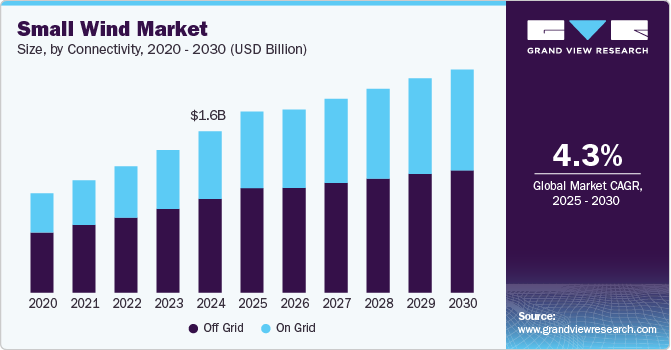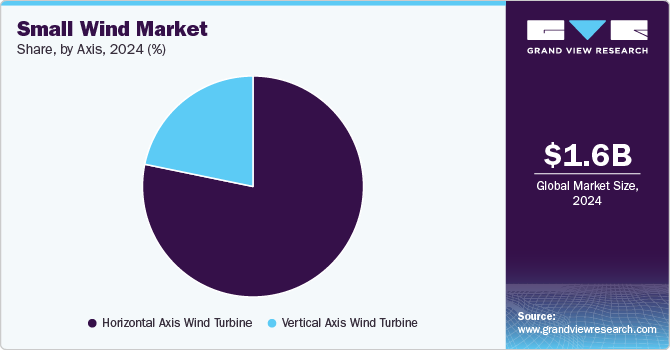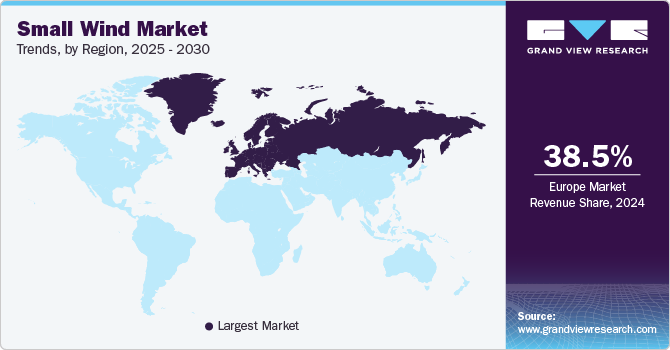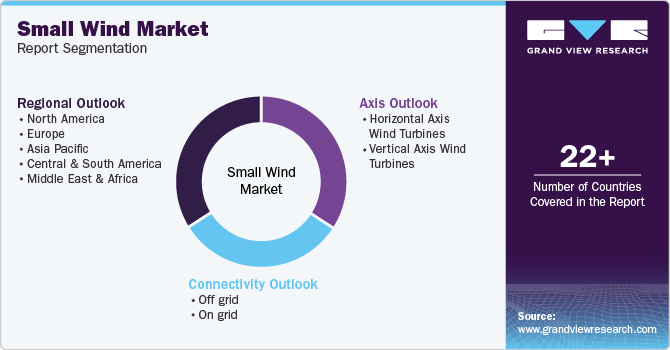
Small Wind Market Size, Share & Trends Analysis Report By Connectivity (Off grid, On grid), By Axis (Horizontal Axis Wind Turbines, Vertical Axis Wind Turbines), By Region, And Segment Forecasts, 2025 - 2030
- Report ID: GVR-1-68038-953-1
- Number of Report Pages: 110
- Format: PDF, Horizon Databook
- Historical Range: 2018 - 2023
- Forecast Period: 2025 - 2030
- Industry: Energy & Power
Small Wind Market Size & Trends
The global small wind market size was estimated at USD 1,601.7 million in 2024 and is projected to grow at a CAGR of 4.3% from 2025 to 2030. The market is primarily driven by the increasing demand for renewable energy sources amid global environmental concerns and the depletion of non-renewable resources. Rapid industrialization and urbanization are amplifying the need for sustainable energy solutions, particularly in remote areas where small wind systems can provide reliable electricity.

Government initiatives, including financial incentives and regulations aimed at reducing carbon emissions, further propel market growth. In addition, advancements in technology and the rising interest from the commercial sector seeking to lower operational costs and enhance sustainability contribute significantly to the expansion of the market.
Drivers, Opportunities & Restraints
A key driver of the market is the growing awareness and acceptance of decentralized energy systems. As consumers and businesses increasingly prioritize energy independence, small wind turbines offer an effective solution for generating on-site power, reducing reliance on traditional grid systems. The integration of smart technologies, such as energy management systems and battery storage, enhances the efficiency and reliability of small wind installations.
Government incentives and favorable policies further enhance adoption, particularly in regions facing energy crises. In addition, technological advancements in turbine efficiency and grid connectivity are expected to facilitate market expansion, making small wind solutions an attractive option for both residential and commercial applications.
The market faces several restraints, primarily including high manufacturing costs and limited economies of scale, which hinder widespread adoption. In addition, the lack of specific legal frameworks and support schemes in many regions restricts market growth. Competition from alternative energy sources, particularly solar power, further complicates the landscape by offering lower costs and easier installation options, making it challenging for small wind solutions to compete effectively.
Connectivity Insights
Based on connectivity, the off grid segment dominated the market with the largest revenue share of 51.9% in 2024. The off grid segment is a vital component of the renewable energy landscape, particularly for providing electricity in remote and rural areas where grid access is limited or non-existent. These systems are designed to operate independently, making them ideal for applications such as powering homes, farms, and telecommunication stations. The growing demand for sustainable energy solutions, coupled with advancements in turbine technology, has enhanced the efficiency and reliability of off-grid small wind systems.
The on-grid segment is expanding within the renewable energy landscape, characterized by small wind turbines connected to the utility grid. This connectivity allows users to generate electricity for residential and commercial applications while contributing excess power back to the grid, thereby enhancing energy security and reducing electricity costs. The market is gaining traction due to increasing government initiatives aimed at improving grid connectivity and promoting renewable energy adoption through financial incentives such as tax credits and feed-in tariffs.
Axis Insights
Based on axis, the horizontal axis wind turbine dominated the market with the largest revenue share of 69.7% in 2024. The growth of horizontal axis wind turbines (HAWTs) is driven by their established efficiency and reliability in harnessing wind energy for electricity generation. As the dominant technology in the wind power sector, HAWTs feature a rotor design that allows for optimal energy extraction, making them suitable for both onshore and offshore applications. The increasing global emphasis on renewable energy sources, coupled with supportive government policies and incentives, has spurred investment in wind energy projects, further propelling the demand for HAWTs.

Technological advancements have also led to improved turbine designs, enhancing performance and reducing costs, which contributes to their widespread adoption across various markets. As countries strive to meet renewable energy targets and reduce carbon emissions, the horizontal axis wind turbine segment is poised for significant expansion.
Regional Insights
The small wind turbine market in North America is experiencing notable growth, driven by increasing demand for renewable energy and a shift towards decentralized power solutions. Government incentives and favorable policies are encouraging investments in small wind technology, particularly in rural areas where traditional grid access is limited.
U.S. Small Wind Market Trends
The small wind turbine market in the U.S. is growing steadily, driven by increasing interest in renewable energy and decentralized power solutions. Supportive government policies and incentives encourage investments in small wind technology, particularly in rural areas. As homeowners seek to reduce energy costs and enhance sustainability, small wind turbines are becoming an attractive option, bolstered by advancements in turbine efficiency and design.
Europe Small Wind Market Trends
Europe small wind market dominated globally and accounted for the largest revenue share of over 38.5% in 2024. The small wind turbine market in Europe is witnessing significant growth, fueled by a strong commitment to renewable energy and supportive government policies. Technological advancements have led to more efficient turbine designs, making them more accessible and economically viable for consumers. The emphasis on reducing carbon emissions and meeting climate goals further propels market growth, particularly in rural areas where decentralized energy solutions are essential. In addition, the integration of small wind turbines into urban settings presents new opportunities for sustainable energy generation, enhancing their appeal in densely populated regions. As environmental concerns continue to rise, small wind turbines are positioned as a viable option for achieving energy independence and sustainability across Europe.

The Germany small wind market is characterized by a strong commitment to renewable energy and government initiatives that promote decentralized power generation. Despite being a leader in onshore wind capacity, the deployment of small wind turbines has been relatively slow compared to other European nations due to lower feed-in tariffs compared to solar power. However, the German government continues to support small wind systems, providing certainty for operators and encouraging investments.
The small wind market in the UK is driven by technological advancements, which have improved turbine efficiency and reduced costs, making small wind systems more accessible to consumers. Increasing awareness of sustainability and energy independence is further enhancing their appeal, particularly in rural areas where traditional grid access is limited. Despite facing competition from alternative energy sources, the integration of small wind turbines into urban environments presents new opportunities for clean energy generation, positioning the UK as a key player in the European market.
Asia Pacific Small Wind Market Trends
The Asia-Pacific small wind turbine market is experiencing rapid growth, fueled by rising urbanization and economic development. Increased energy demand, particularly in rural and off-grid areas, drives the adoption of small wind systems as effective renewable energy solutions. Government initiatives and favorable policies further support market expansion, encouraging investments in sustainable technologies. In addition, advancements in turbine efficiency and design enhance the viability of small wind turbines, making them more accessible to consumers. As countries in the region prioritize environmental sustainability and energy independence, the market is positioned for significant growth in the coming years.
China's small wind market is the largest in the Asia Pacific region, driven by rapid urbanization, industrialization, and a significant increase in electricity demand. The country's focus on expanding electricity infrastructure and integrating renewable energy sources fuels the growing adoption of small wind turbines to ensure reliable power transmission.
The small wind turbine market in Japan is experiencing notable growth, driven by increasing demand for renewable energy and government initiatives promoting sustainable power solutions. As the country seeks to enhance energy independence and reduce carbon emissions, small wind systems are becoming an attractive option for both residential and commercial applications.
Central & South America Small Wind Market Trends
The small wind turbine market in Central and South America is experiencing significant growth, driven by increasing investments in renewable energy and supportive government policies. Countries like Brazil, Chile, and Colombia are leading this expansion, focusing on both onshore and offshore wind projects. The rising demand for sustainable energy solutions, particularly in rural and remote areas with limited grid access, further fuels market adoption.
Middle East & Africa Small Wind Market Trends
The small wind turbine market in the Middle East and Africa is driven by growing energy demand and increased investments in renewable energy. Supportive government policies promote clean energy initiatives, encouraging the development of wind projects.
Key Small Wind Company Insights
The market for small wind turbines is characterized by a diverse landscape of companies focused on innovation and sustainability. Key players include established manufacturers such as Bergey Windpower, Northern Power Systems, and Kliux Energies, which are investing heavily in research and development to enhance turbine efficiency and reduce costs. The market is also witnessing the emergence of startups introducing advanced technologies, such as smart sensors and bladeless turbines, aimed at improving performance and accessibility. Government incentives and growing awareness of renewable energy benefits are driving market expansion, while competition from solar energy poses challenges. Overall, the small wind turbine sector is poised for growth as it addresses energy needs in both urban and rural settings.
Key Small Wind Companies:
The following are the leading companies in the small wind market. These companies collectively hold the largest market share and dictate industry trends.
- Envergate Energy AG
- Kingspan Group
- Kliux Energies
- superwind GmbH
- Bergey Windpower Co.
- EOCYCLE
- Shanghai Zhiyuan Green Energy Co., Ltd.
- Northern Power Systems
- XZERES Corp.
Recent Developments
-
In October 2024, Envision Energy announced the launch of a 5MW onshore model in India, aiming to strengthen its growing presence in the market. This 5MW turbine will be among the largest available in India, second only to a 5.2MW model produced by Adani New Industries, which began operations earlier in 2024.
-
In October 2024, Skyborn Renewables, a subsidiary of Global Infrastructure Partners (GIP), formed a significant partnership in the U.S. offshore wind sector by acquiring a 50% stake in the Revolution Wind and South Fork Wind projects from Eversource Energy. With Ørsted retaining the other 50% stake in both projects, Skyborn will co-manage these developments. This collaboration marks an important step in expanding Skyborn's footprint in the U.S. offshore wind market, leveraging the combined expertise of both companies to advance these critical renewable energy initiatives.
Small Wind Market Report Scope
|
Report Attribute |
Details |
|
Market size value in 2025 |
USD 1,796.2 million |
|
Revenue forecast in 2030 |
USD 2,213.9 million |
|
Growth rate |
CAGR of 4.3% from 2025 to 2030 |
|
Historical data |
2018 - 2023 |
|
Base Year |
2024 |
|
Forecast period |
2025 - 2030 |
|
Quantitative units |
Revenue in USD million/billion and CAGR from 2025 to 2030 |
|
Report coverage |
Revenue forecast, competitive landscape, growth factors, and trends |
|
Segments covered |
Connectivity, axis, region |
|
Regional scope |
North America; Europe; Asia Pacific; Central & South America; Middle East & Africa |
|
U.S.; Canada; Mexico; Germany; France; UK; Italy; Spain; Russia; China; India; Japan; Australia; Brazil; Argentina; Saudi Arabia; South Africa; UAE |
|
|
Key companies profiled |
Envergate Energy AG; Kingspan Group; Kliux Energies; superwind GmbH; Bergey Windpower Co.; EOCYCLE; Shanghai Zhiyuan Green Energy Co. Ltd.; Northern Power Systems; XZERES Corp. |
|
Customization scope |
Free report customization (equivalent up to 8 analyst’s working days) with purchase. Addition or alteration to country, regional & segment scope |
|
Pricing and purchase options |
Avail customized purchase options to meet your exact research needs. Explore purchase options |
Global Small Wind Market Report Segmentation
This report forecasts revenue growth at global, regional, and country levels and provides an analysis of the latest industry trends in each of the sub-segments from 2018 to 2030. For this study, Grand View Research has segmented the global small wind market report based on connectivity, axis, and region:

-
Connectivity Outlook (Capacity, MW; Revenue, USD Million, 2018 - 2030)
-
Off grid
-
On grid
-
-
Axis Outlook (Capacity, MW; Revenue, USD Million, 2018 - 2030)
-
Horizontal Axis Wind Turbines
-
Vertical Axis Wind Turbines
-
-
Regional Outlook (Capacity, MW; Revenue, USD Million, 2018 - 2030)
-
North America
-
U.S.
-
Canada
-
Mexico
-
-
Europe
-
Germany
-
UK
-
Italy
-
Spain
-
France
-
Russia
-
-
Asia Pacific
-
China
-
India
-
Japan
-
Australia
-
-
Central & South America
-
Brazil
-
Argentina
-
-
Middle East & Africa
-
Saudi Arabia
-
South Africa
-
UAE
-
-
Frequently Asked Questions About This Report
b. The global small wind market size was estimated at USD 1,601.7 million in 2024 and is expected to reach USD 1,796.2 million in 2025.
b. The global small wind market is expected to grow at a compound annual growth rate of 4.3% from 2025 to 2030 to reach USD 2,213.9 million by 2030.
b. Europe dominated the small wind market with a share of over 38.5%% in 2024. Germany and the U.K. held the maximum share in Europe, virtually dominating the market primarily owing to large-scale funding received by both countries cumulatively.
b. Some key players operating in the small wind market include Envergate, Kingspan Wind, Kliux Energies, Superwind, Bergey Windpower Co., Eocycle Technologies, Shanghai Ghrepower Green Energy, Northern Power Systems, and Xzeres Wind Corporation
b. Key factors that are driving the small wind market growth include owing to the global energy crisis coupled with depleting non-renewable resources for electricity generation.
We are committed towards customer satisfaction, and quality service.
"The quality of research they have done for us has been excellent."




